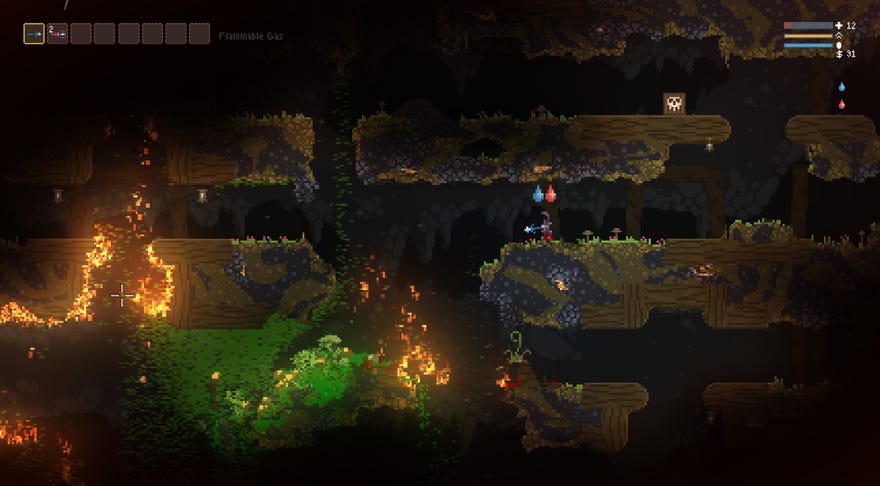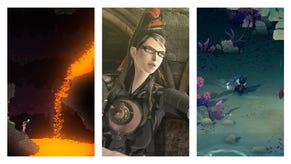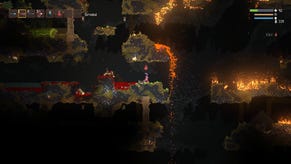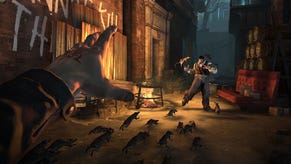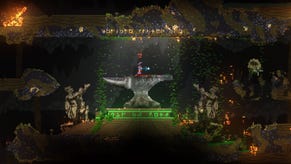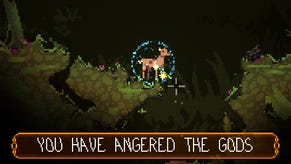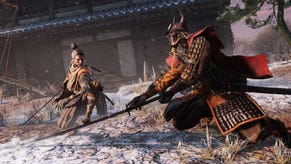Premature Evaluation: Noita
Everything is on fire
As you might have already surmised, Noita is a side-scrolling roguelike in which every pixel is meticulously simulated, from the fanciest molecule of glowing gas down to the lowliest granule of common dirt.
Each pebble, spark and drop of water interacts dynamically with everything else. Liquids slosh and flow and form pools, steam and smoke billow upwards and gather along the ceiling in suffocating clouds. Every part of the environment can be exploded, frozen, evaporated, set alight or extinguished in a deluge of toxic sludge and blood. Seams of coal smoulder like long fuses, ice melts into water and burning wooden beams break apart, sending lit splinters falling like matches into carelessly positioned vats of oil.
But the game’s procedurally generated caves are more than your standard destructible environments. They’re more like elaborate, organic bombs, just waiting for an errant spark from a misfired wand to kickstart a fiery chain reaction that tears through half of the level. Stand still and you’ll usually hear the sound of distant explosions as off-screen enemies knock over lanterns and ignite far away piles of gunpowder. As you descend through each level, you’ll occasionally stumble across a smoking, blood-spattered hole where some section of the cave once was, now accidentally obliterated by clumsy cave gremlins long before you even arrived.
It’s the kind of concept that sounds great on paper, but Noita manages to lend just enough structure to its physics toybox to bring some order to the chaos. You’re a little wizard person, armed with wands that each spit out gunk of various shapes and elemental flavours, and tasked with descending as far into the earth as you’re able before meeting your (usually surprising) demise.
Your wizard’s cloak can be become soaked in stuff. So if you’re covered in blood, you’re less likely to catch fire. If you’ve become doused in oil or splashed with whiskey, you should stay away from open flames. Taking a dunk in a pool of the right kind of liquid will wash the dirt off and extinguish any flames, and so keeping a mental note of the nearest friendly puddle becomes one of the first survival tactics you learn.
As you play and die, and die, and die again, you naturally begin to accrue vital knowledge of what all of the various types of green gloop and hot redness do, and how afraid you should be of everything. You are like a growing baby, one that’s been forced to live inside a dark cave and to learn about the environment by rolling around and smearing yourself with it. The pink slurry that some monsters are made of, you’ll discover, is a great insulator against fire, but slows you down to a crawl. Pick up a potion and you can throw it at a monster, or you can right click to spray it all over yourself like you’ve won some kind of horrible Grand Prix. I once accidentally dropped a flagon of teleportation juice and rematerialised, by chance, at the bottom of a small pit of lava on the opposite side of the level.
It is a clever, surprising and frantic roguelike, but despite the game’s attempts to mitigate the confusion as best it can, Noita is sometimes a little too chaotic. The interaction of different enemies and materials leads to situations so wild and unpredictable that it’s impossible to take things slowly, or to strategise your way through levels. Whereas Spelunky let you peek over the next cliff edge or into the adjacent room to plan your next step, in Noita you seem to be always on the backfoot, locked in a state of constant, floundering reaction. You are the wizarding version of Mr. Bean, and the situation around you is nearly always collapsing, or melting, or on fire, or dissolving under a wave of corrosive acid.
None of this is to say the game is unfair – apart from the odd time you become lodged inside the environment, which feels almost inevitable when individual pixels can be chipped away – but it is very challenging, and death nearly always feels like the result of a dice roll gone wrong. Between each level is a safe haven where you can heal and replenish your wands, and it’s here that the game offers you some useful safeguards from itself.
There’s a shop where you find dozens of new spells, which combine with one another inside a wand to create a seemingly infinite variety of effects, from harmless popping bubbles and useless whiskey bombs to wandering, all-consuming black holes and elemental blasts so powerful that you’ll obliterate yourself in one click while somehow simultaneously electrifying every body of water on the level. These wands and their randomised attributes can be found dotted around the levels too, and your success in any given run will largely depend on whether you can collect enough gold to buy one, or find one that’s useful at killing enemies without also backfiring and sending your charred corpse hurtling into oblivion.
Between levels you can also pick from one of three randomly offered perks, which shape the way you play even further. Find the fire immunity perk and you can safely juice up your wand with fire trails, and become a sort of napalm dispensing hover-mage. Select something less useful like teleportitis and you’ll teleport each time you take damage (although if you catch on fire, as I discovered, you’ll become stuck in a teleportation loop that pings you around the level randomly until you die or are lucky enough to appear inside a pool of water).
Through your choice of wands and perks you'll be playing with an entirely different set of abilities by the time you've reached the second or third cave. And while the dispensing of fortune feels too much like a lottery in this early access version, there’s already the structure of a compelling and original roguelike here. Noita and every last one of its simulated pixels is absolutely good, and you should play it.
